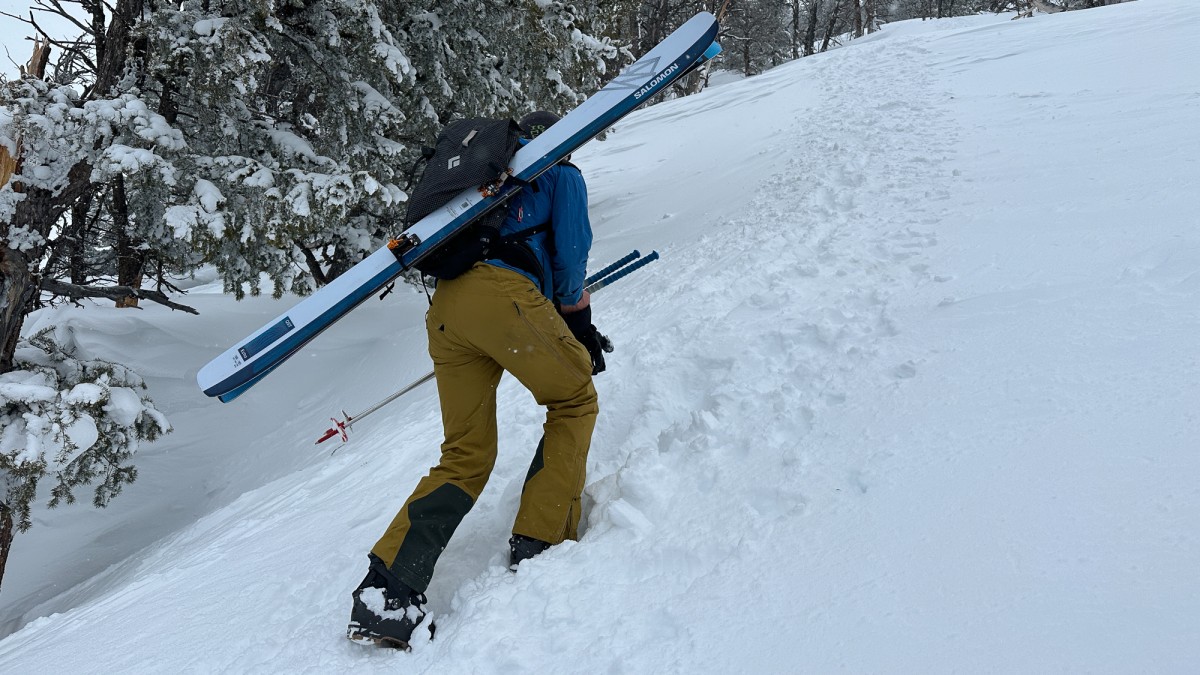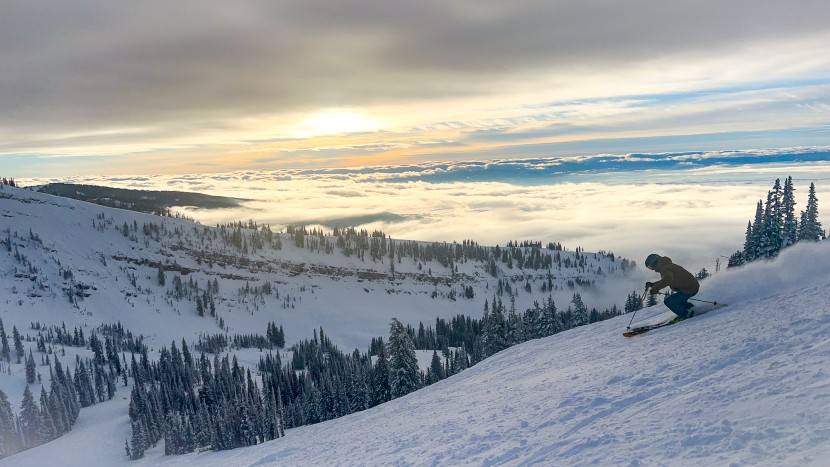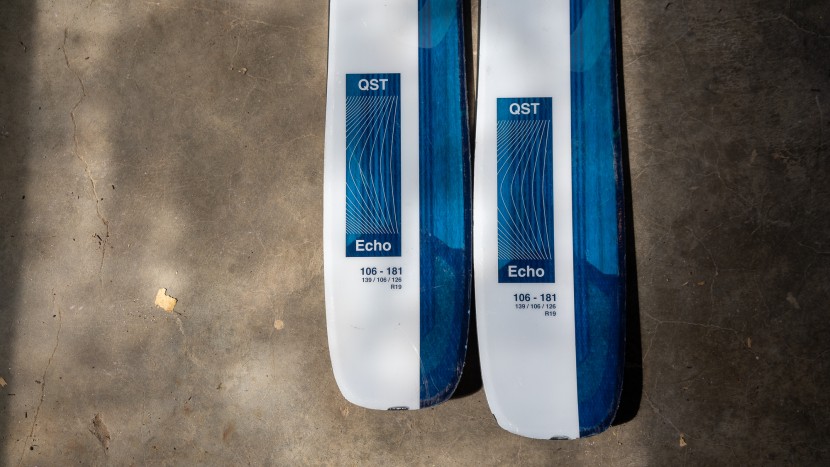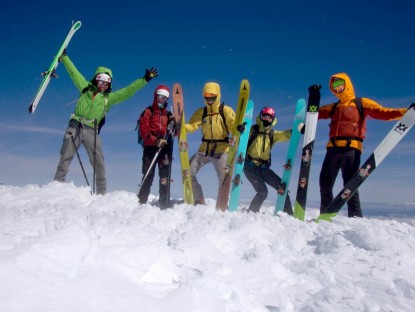Salomon QST Echo 106 Review
Our Verdict
Compare to Similar Products
 This Product
Salomon QST Echo 106 | |||||
|---|---|---|---|---|---|
| Awards | Optimized for Downhill Performance | Best Overall Backcountry Skis | Best Bang for the Buck | ||
| Price | $639.96 at Evo Compare at 2 sellers | $719.96 at Amazon Compare at 3 sellers | $800 List | $849.00 at REI Compare at 3 sellers | $469.95 at Amazon Compare at 2 sellers |
Overall Score  |
|||||
| Star Rating | |||||
| Bottom Line | Heavier skis that offer meaningful performance on the downhill, ideal for newer backcountry skiers or for experts who don't mind trading a bit of efficiency for a bit more fun | This relatively wide all-season ski is one of our favorites and great for all-around human-powered use | Reasonably affordable and great for a wide range of human-powered skiing, these are your backcountry "quiver-of-one" | One of the best on the market, there is nothing remarkable about these skis, and that is a good thing | Skis optimized for downhill performance across many circumstances and skillsets, but you'll pay a price in weight |
| Rating Categories | Salomon QST Echo 106 | Blizzard Zero G 105 | K2 Wayback 106 | Black Crows Camox F... | Elan Ripstick 106 |
| Weight (25%) | |||||
| Firm Snow (20%) | |||||
| Powder (20%) | |||||
| Crud and Poor Snow (20%) | |||||
| Stability at Speed (15%) | |||||
| Specifications | Salomon QST Echo 106 | Blizzard Zero G 105 | K2 Wayback 106 | Black Crows Camox F... | Elan Ripstick 106 |
| Measured Weight Per Ski (g) | 1779 | 1513 | 1436 | 1510 | 1858 |
| Measured Length Tested (cm) | 180 | 178 | 179 | 182 | 177 |
| Measured Waist Width (mm) | 105 | 105 | 105 | 97 | 106 |
| Weight Per Surface Area Ratio (g/cm²) | 0.8 | 0.72 | 0.68 | 0.71 | 0.86 |
| Measured Weight Per Pair (g) | 3557 | 3025 | 2872 | 3024 | 3715 |
| Measured Weight Per Pair (lbs) | 7.8 | 6.7 | 6.3 | 6.7 | 8.2 |
| Manufacturer Claimed Length (cm) | 181 | 180 | 179 | 183 | 180 |
| Available Lengths (cm) | 157, 165, 173, 181, 189 | 164, 172, 180, 188 | 165, 172, 179, 186 | 157.1, 164.3, 172.1, 178.4, 183.4 | 167, 174, 181, 188 |
| Measured Dimensions, Tip/Center/Tail (mm) | 140/105/125 | 133/104/118 | 131/105/120 | 137/97/117 | 143/105/119 |
| Manufacturer Claimed Dimensions (mm) | 136/106/126 | 133/105/119 | 132/106/121 | 130/97/115 | 143/106/120 |
| Turn Radius (m) | 19 | 23 | 22.3 | 18 | 19.5 |
| Construction Type | Sandwich | Sandwich | Semi-Cap | Sandwich | Sandwich |
| Core Material | Poplar, Caruba | Paulownia | Paulownia | Paulownia, Poplar | Tubelite |
| Rocker/Camber Profile | Tip and tail rocker, camber underfoot | Tip and tail rocker | Tip and tail rocker, flat underfoot | Tip rocker, camber underfoot | Tip and tail rocker, camber underfoot |
Our Analysis and Test Results
When the downhill part of your backcountry ski day matters the most, choose the Salomon QST Echo 106, especially if the snow is soft or variable. These weigh more than we usually recommend, but they ski way better than expected.
Weight
This is a heavy ski for human-powered adventures. Our tester pair weighed 1784 and 1773 grams, respectively. Using the common convention of discussing ski weights in grams per ski, that's an average of 1779 grams per ski. That makes for an average of 3557 grams, or 7.8 pounds for the pair or 3.9 pounds per ski.
No matter how you look at it, the QST Echo 106 is heavier than has become typical for backcountry skis. You will see advertising and catalog copy mention their low weight, but this is relative to the rest of Salomon's line. As compared to resort skis, these are indeed lightweight. As compared to the other modern touring skis in our lineup, they are quite heavy. But it's important to point out that these heavier skis also don't perform better than the Echo 106.
Firm Snow
You don't typically choose 106 mm-waisted backcountry skis for firm snow. You also don't typically expect skis with a soft longitudinal flex pattern to do well on firm snow. Throw out your typical expectations with the QST Echo 106. These ski firm snow as well as other narrower, stiffer options. Therein is a recommendation for these skis and a cautionary tale in trying to generalize about specific construction or design attributes. Ski design and performance are complex and relative.
The outstanding firm snow performance of the Echo 106 is likely credited to the relatively stiff torsional flex pattern. With all of the skis we tested, we made a comparative examination of the torsional flex by performing a rudimentary “twisting” motion of the ski. Very few skis in our lineup were as resistant to this type of flex as the Echo 106. As long as you stick to lower, “backcountry appropriate” speeds and ski energy levels, these skis will handle whatever firm conditions you want to throw them into.
Powder
Simply put, everybody loved the powder performance of the Echo 106. There is something about the way this ski pops and floats that makes it feel like a much bigger ski. Our testers felt like it skied low angle, deep snow more like a 120 mm ski.
When compartmentalizing backcountry skis, we often say something like, “These are great all-around skis that ski powder well.” We'd flip that script for the Echo 106. These are great powder skis that ski everything else really well. But the important takeaway from this metric is that they ski powder like bigger, purpose-built powder skis. That's a very good thing.
Crud and Poor Snow
We don't necessarily like leaning on weight so much in our discussion of ski performance. We would like to be more nuanced or sophisticated in our assessment. However, the more we do this, the more we realize that weight is the best way to ski tougher snow. Bigger, heavier skis simply shred tough snow better than smaller, lighter skis do – it's physics. Since the Echo 106 is heavy, it performs well in poor snow conditions.
That said, we can acknowledge when poor snow performance transcends our expectations for a given weight class. For their weight, the Echo 106 skis much better than directly comparable models in sloppy snow or breakable crusts. Even across testers, conditions, and accompanying boots, these skis track well with predictable edge engagement and reliable control. The consistency of our findings gives us the confidence to say that the Echo 106 skis cruddy snow well. If you particularly struggle in tough snow, the added weight of the Echo 106 is likely justified. These are excellent skis for the super fit uphill athlete who is newer to – or clumsier with – downhill skiing.
Stability at Speed
For most backcountry skiers in most circumstances, downhill speed should be regulated more by the potential consequences of a high-speed fall than by the stability of our skis. No matter how predictable your skis are, smacking into something at high speed – away from the comforts of a ski patrol – is bad news.
Despite its penchant for crushing in most conditions, the QST Echo 106 is less stable at speed than we were expecting. Bigger, stiffer skis in our test – even those that weigh about the same – are a little more steady at high speed and in steep terrain. The Echo 106 isn't “wobbly,” but it doesn't have the locked-in feeling afforded by even burlier skis. But compared to anything lighter or smaller, this ski is rock solid.
Should You Buy the Salomon QST Echo 106?
The ski guides on our test team have seen a wide spectrum of skiers in the backcountry. The extra weight of the Echo 106 is justified for folks who really want to optimize downhill performance. While we all want to make the downhill more fun, there is always a balance to strike in the backcountry. Efficiency uphill is a function of gear weight and fitness. For less-experienced backcountry skiers who are quite fit and efficient on the uphill but have a lower level of skill on the downhill, the tradeoff of the Echo 106 makes a lot of sense. Alternatively, if you are super fit and, for whatever reason, you know that you will be ascending at rates and volumes well below your capabilities, then this ski will make the downhill portions of your day that much more enjoyable.
What Other Backcountry Skis Should You Consider?
We have also enjoyed the Elan Ripstick 106, which is a bit livelier at high speeds but doesn't offer the same smooth performance in powder or poor snow conditions. If you want a ski in a lower weight class, alternatives to the QST Echo 106 are plentiful. The lighter weight Blizzard Zero G 105 is similarly sized but offers a better balance of uphill and downhill performance.














